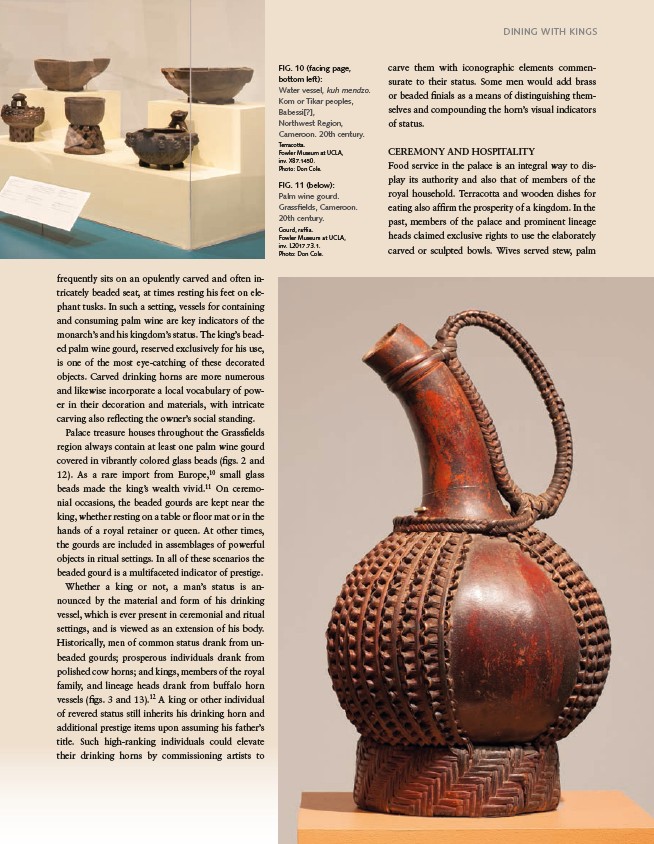
DINING WITH KINGS
95
frequently sits on an opulently carved and often intricately
beaded seat, at times resting his feet on elephant
tusks. In such a setting, vessels for containing
and consuming palm wine are key indicators of the
monarch’s and his kingdom’s status. The king’s beaded
palm wine gourd, reserved exclusively for his use,
is one of the most eye-catching of these decorated
objects. Carved drinking horns are more numerous
and likewise incorporate a local vocabulary of power
in their decoration and materials, with intricate
carving also reflecting the owner’s social standing.
Palace treasure houses throughout the Grassfields
region always contain at least one palm wine gourd
covered in vibrantly colored glass beads (figs. 2 and
12). As a rare import from Europe,10 small glass
beads made the king’s wealth vivid.11 On ceremonial
occasions, the beaded gourds are kept near the
king, whether resting on a table or floor mat or in the
hands of a royal retainer or queen. At other times,
the gourds are included in assemblages of powerful
objects in ritual settings. In all of these scenarios the
beaded gourd is a multifaceted indicator of prestige.
Whether a king or not, a man’s status is announced
by the material and form of his drinking
vessel, which is ever present in ceremonial and ritual
settings, and is viewed as an extension of his body.
Historically, men of common status drank from unbeaded
gourds; prosperous individuals drank from
polished cow horns; and kings, members of the royal
family, and lineage heads drank from buffalo horn
vessels (figs. 3 and 13).12 A king or other individual
of revered status still inherits his drinking horn and
additional prestige items upon assuming his father’s
title. Such high-ranking individuals could elevate
their drinking horns by commissioning artists to
carve them with iconographic elements commensurate
to their status. Some men would add brass
or beaded finials as a means of distinguishing themselves
and compounding the horn’s visual indicators
of status.
CEREMONY AND HOSPITALITY
Food service in the palace is an integral way to display
its authority and also that of members of the
royal household. Terracotta and wooden dishes for
eating also affirm the prosperity of a kingdom. In the
past, members of the palace and prominent lineage
heads claimed exclusive rights to use the elaborately
carved or sculpted bowls. Wives served stew, palm
FIG. 10 (facing page,
bottom left):
Water vessel, kuh mendzo.
Kom or Tikar peoples,
Babessi?,
Northwest Region,
Cameroon. 20th century.
Terracotta.
Fowler Museum at UCLA,
inv. X87.1450.
Photo: Don Cole.
FIG. 11 (below):
Palm wine gourd.
Grassfields, Cameroon.
20th century.
Gourd, raffia.
Fowler Museum at UCLA,
inv. L2017.73.1.
Photo: Don Cole.